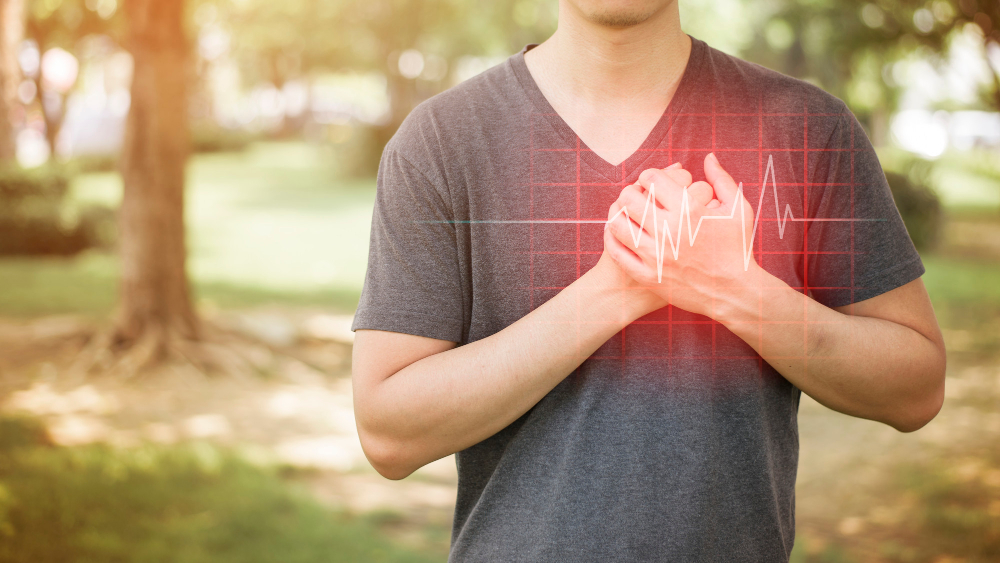The heart is a muscular organ composed of four chambers, with two upper chambers, the atria, and two lower chambers, the ventricles. The atria receives the blood, while the ventricles are responsible for pumping the blood to rest of the body. All of us have experienced the sensation of our heart beating rapidly at some point. It is a common occurrence, except when it feels like a flutter in the chest or neck, which can be indicative of arrhythmia.
Knowing arrhythmia
Arrhythmias is a medical condition in which the heart beats at an irregular rate or rhythm. This is caused by electrical impulses produced by the pacemaker, or other small foci, which travel through the heart muscles and cause the heart to beat at a regulated rate. Alterations in the sequence or timings of these impulses can lead to irregular heartbeats. As a result, the heart may beat rapidly or slowly. Tachycardia is a condition in which the heart rate is greater than 100 beats per minute, while a heart rate below 60 beats per minute is referred to as bradycardia.
Causes
Arrhythmia occurs when there is a defect in either the generation or the conduction of electrical pulses in the heart. This is because the pacemaker that generates these pulses may not work properly, or the channels that send signals to other parts of the heart may become blocked. As a result, the heart is unable to beat like a synchronized set of muscles. There are many reasons for abnormal electrical impulses. For example, if there is a focus other than that of the main pacemaker, then new impulses will be generated. These new impulses will add to the impulses coming from the pacemaker, resulting in an abnormal heart rhythm or pulse rate.
The most common cause of arrhythmias is a heart attack. A heart attack occurs when the heart muscles die due to a lack of blood flow and oxygen. A heart attack damages the electrical system of the heart. Other conditions affecting the heart can also affect the electrical system. These conditions include heart failure and very high blood pressure. Other factors that affect heart rate include alterations in thyroid gland activity, smoking, alcohol, and some drugs (cocaine and amphetamines). Arrhythmias may also be congenital. Some pacemakers or conduction pathways are malformed from birth.
Types
Arrhythmias typically fall into one of four categories: premature beats, supraventricular arrhythmias, ventricular arrhythmias, and bradyarrhythmias.
Premature beats: This is one of the most common form of arrhythmia. It’s a beat that comes earlier than normal, followed by a break, and then there’s a more intense beat that you can feel. These beats may occur within the atria (Premature Atrial Contraction) or ventricles (Premature Ventricular Contraction).
Supraventricular arrhythmias: This consists of paroxysmal atrial tachycardia (PAT) or paroxysmal supraventricular tachycardia (PSVT). Electrical signals generated at new locations in the atria. These electrical signals interfere with electrical signals from the sinus node, the heart’s natural pacemaker. A series of early heartbeats in the atria increase the heart rate. The heart does not have enough time to fill before contracting, which reduces blood flow to other parts of the body.
Ventricular arrhythmias: This include Ventricular Tachycardia (VT), which is a type of arrhythmia that involves electrical impulses coming from your heart’s natural pacemaker to your ventricles. These impulses interfere with your natural pacemaker, causing your heart rate to rise and your ventricles do not have enough time to fill before contracting.
VT is usually caused as a result of another condition, such as a heart attack or an abnormality in your heart muscles or one of your valves. It can also occur as a consequence of taking certain medicines used to treat arrhythmia, exercise, emotions, or sudden changes in your posture.
Bradyarrhythmias: This can occur even in the absence of an underlying arrhythmia, such as during sleep, in the elderly, or in athletes. A low heart rate (bradyarrhythmia) is a condition in which the heart beats at a rate of below 60 beats per minute (BPM).
Bradyarrhythmias can be caused by several factors, including a defect in the heart’s natural pacemaker or in the conduction path, either as a result of a heart attack or due to heart disease. It can also be caused by other medical conditions, such as a low body temperature.
Seriousness of Arrhythmias
In most cases, premature beats aren’t life-threatening. They’re more common in teens and young children, and they usually have no underlying cause and do not require treatment.
Supraventricular tachycardias (SVT) can occur in children, women, anxious individuals, and those who smoke excessively, consume alcohol, consume caffeine, or are physically fatigued. In some cases, SVT may not be life-threatening. However, it can occur in the event of a heart attack, as well as in the case of a diseased heart valve. In the most severe cases, SVT can result in unconsciousness or cardiac arrest. A life-threatening form of SVT, known as Wolff–Parkinson–White syndrome occurs when the heart’s electrical signals travel along an extra pathway from the atria to the ventricles, interrupting the normal flow of signals.
Ventricular Tachycardia (VT) is an arrhythmia that occurs in the ventricle and may be more severe than atria tachycardia. VT lasting a few seconds doesn’t cause much damage, but long-lasting ones can lead to loss of consciousness and cardiac arrest. It may eventually develop into fibrillation (another arrhythmia).
Atrial Fibrillation (AF) is a condition in which disordered abnormal signals are produced in several foci of the atria and cause a heart rate of up to 300 beats per minute. In this case the atria can’t contract and just quiver. AF can lead to heart failure and complications. Ventricular Fibrillation (VF) is a similar condition that occurs in the heart’s ventricles.
Diagnosis
Arrhythmia is a condition in which the heart beats abnormally fast, slowly, or irregularly, or the heart appears to stop for a period of time. Symptoms may include anxiety, dizziness, or weakness. Additionally, you may faint, perspire, experience chest pain, or have difficulty breathing.
You may need to have some tests to check for arrhythmias. An EKG (electrocardiogram) is a test that shows the electrical activity of the heart. The EKG is done by placing several leads and wires on the patient’s skin.
You might have to wear a Holter monitor to monitor your heart rhythm. A Holter monitor is a portable, small device that you wear 24 hours a day to continuously record your EKG as you go about your day. You may also need to run on a treadmill to allow the doctor to generate and record the electrical activity of your heart, which may not be visible at rest or during normal activity.
Other tests may be performed, such as a tilt table test, event recorder, and Magnetic source imaging.
Treatment
Medications used to treat arrhythmia include antiarrhythmic drugs that help to restore normal heart beat and rhythm. Blood thinning drugs (aspirin, warfarin and heparin) may prevent clotting. Other medical conditions such as high blood pressure or abnormal thyroid function may also require treatment.
In some cases, a pacemaker may be necessary to stimulate the heart to beat normally. In other cases, an electrical pulse may be necessary. These are referred to as cardioversion or defibrillation. These devices are typically implanted beneath the skin of the chest. If medications do not provide adequate relief, a thin flexible tubing may be threaded through the veins in the hand or upper thigh until the heart and the energy transmitted through the tube can eliminate the abnormal foci responsible for the abnormal heartbeats, a process known as catheter ablation.
Surgery may be necessary to treat underlying conditions such as a blocked vessel or a defective valve in the heart or to make small incisions or burns that stop the transmission of disordered signals in the heart. You may also be recommended to perform vagal maneuvers such as gagging, immersion of the face in cool water, holding your breath and bearing down. These techniques affect vagus nerves that regulate heart rate.
Beating heart arrhythmias
Despite the fact that the majority of arrhythmias are not life-threatening, it is recommended to seek medical attention if an abnormal heart rhythm is present. Through appropriate treatment and preventive measures, it is possible to prevent and manage arrhythmias and maintain your heart health.



